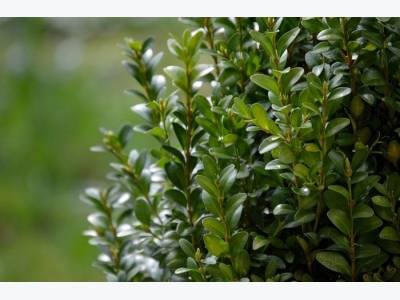How to Grow Boxwood Shrubs

Boxwoods (Buxus) were first introduced in America from England in 1652. Colonists planted them widely and they still can be found in old colonial gardens throughout the East Coast.
With their small, evergreen leaves, boxwoods are most widely used as tightly clipped hedges, but they can be allowed to take a more natural form or clipped into topiaries or balls.
There are three species of boxwoods – English (B. sempervirens), Japanese (Buxus microphylla var. japonica) and American or common boxwood (Buxus sempervirens, L). English boxwood is a true dwarf type, usually remaining under 4 feet tall. It is the most commonly grown species. Japanese boxwood was first introduced in 1890. Cultivars can grow up to 8 feet tall and 20 feet wide. Japanese boxwood is typically grown in the south because it is more heat tolerant than other varieties. Common boxwood is a cold-tolerant shrub or tree that can grow to 20 feet tall or more. All three species thrive in the USDA plant hardiness zones 5 through 8, although some cultivars are more adaptable.
Growing Boxwood Shrubs
Boxwoods are fairly adaptable, but they’ll grow best if you give them their preferred growing conditions. Although evergreen, boxwoods are prone to winter bronzing, especially when planted in an unprotected location. The best spot for them is on the north or northeastern side of the house in partial shade to full sun. Morning sun with a little afternoon shade is ideal.
Boxwoods grow best in light, loamy or sandy soil. They’re prone to root rots in clay soils so amend such soils to lighten them or plant boxwoods in raised beds. Also, avoid planting boxwoods in low-lying areas that tend to stay wet after rainfall. They also prefer a soil pH between 6.0 and 7.5. Amend acidic soils with lime the fall before you plant boxwoods.
Boxwoods grow slowly. Some varieties grow as little as 1 inch per year. These long-lived plants can take as much as 10 to 15 years to reach their mature height. Because of this slow growth, they don’t respond well to heavy pruning. Instead, prune them lightly each winter to remove any dead or diseased branches and to open up the plant, if necessary. If you want a clipped form, trim them with hedge clippers two or three times each season, trimming back only ½ inch at a time. If you’re growing a hedge, make sure the top of the hedge is slightly narrower than the bottom so light can reach the lower portions of the plants.
Fertilize boxwoods in early spring before new growth emerges with about 1 cup of 10-10-10 fertilizer per 100 feet of row. If you have sandy soil, make an additional application in early summer, but don’t fertilize boxwood in late summer. Boxwoods need consistently moist, but not soggy, soil. Water two or three times per week, or as needed, to keep the soil moist 1 inch beneath the surface. Mulch with 2 inches of wood chips or bark to help keep the soil moist.
Propagating Boxwood
Because boxwoods grow so slowly, most gardeners prefer to grow them from established nursery plants. However, you can also propagate boxwoods from cuttings. Cut a 5- to 6-inch piece from a vigorously growing branch. Remove the leaves from the bottom two inches of the stem and place it in a cutting medium such as coarse sand. Keep the medium moist and place the cutting in a sunny location. Transplant it when you notice roots growing from the cutting – typically in two to four weeks.
Boxwood Problems
The most common problem with boxwoods is winter injury, which causes browning leaves. While this condition won’t kill the plant, it isn’t particularly attractive. Winter bronzing is normal on Japanese varieties, but you can prevent it in other cultivars by placing the plants in a protected location or wrapping them loosely with burlap during the winter. Make sure they received adequate water and fertilizer during the growing season and water them occasionally during the winter if conditions are dry.
Sucking insects, such as aphids, psyllids and spider mites, sometimes infest boxwood. You may notice drooping leaves and honeydew, a sticky substance, on the leaves and ground. Treat these pests with insecticidal oil or an insecticide labeled for their use.
Boxwood decline is a disease that sometimes afflicts English boxwoods. Characterized by slow growth and a gradual decline in health, this condition can be minimized by providing proper growing conditions.
Related news
 How to Grow Eucalyptus Trees
How to Grow Eucalyptus Trees Native to Australia, eucalyptus trees are known for their round, silver leaves that form on stiff branches. These branches are often used in fresh and dried
 How to Get Rid of Invasive Bamboo
How to Get Rid of Invasive Bamboo Bamboo is a beautiful plant from Asia. There, nature provides a balance of predators and disease that keep bamboo in check.
 How to Grow Crossvine
How to Grow Crossvine Crossvine is a graceful vining plant loaded with lustrous green leaves and bright, trumpet-shaped flowers during late spring and throughout summer.